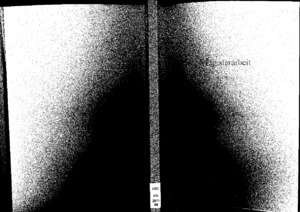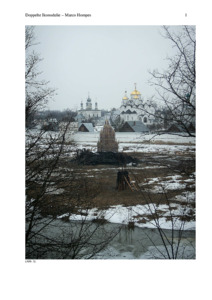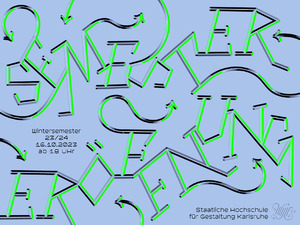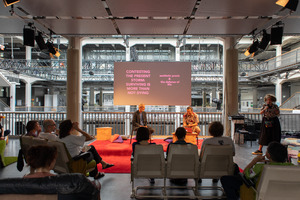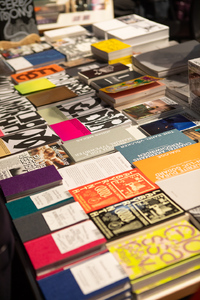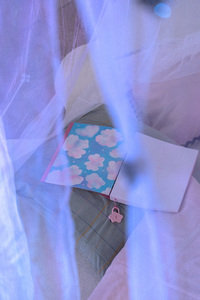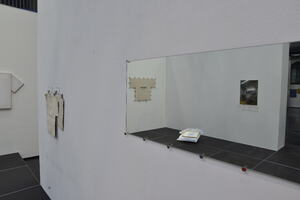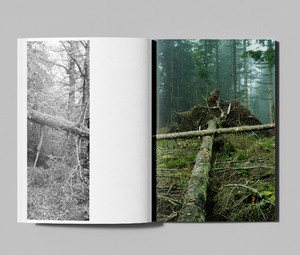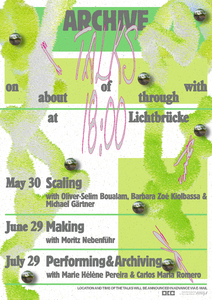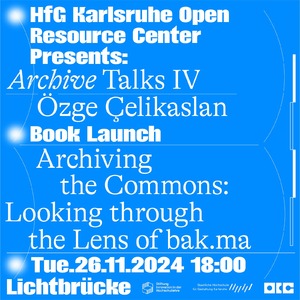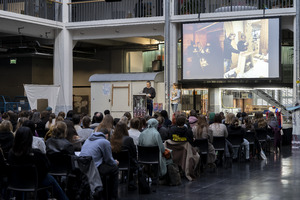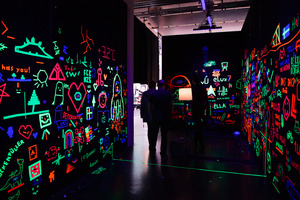"Staatliche Hochschule für Gestaltung (HfG) Karlsruhe"
| Begriff | Staatliche Hochschule für Gestaltung (HfG) Karlsruhe |
| Metakey | Ort: Institution (creative_work:location_institution) |
| Typ | Keyword |
| Vokabular | Werk |
92 Inhalte
Filter werden geladen
- Seite 1 von 8
Die Methode Duchamp – Magritte
- Titel
- Die Methode Duchamp – Magritte
- Untertitel
- Das „Musée d’Art Moderne. Département des Aigles” von Marcel Broodthaers unter dem Aspekt der strategischen Aneignung
- Autor/in
- Beschreibung (de)
- „Der Fall Marcel Broodthaers lädt den Rezipienten dazu ein, sich mit dessen Vorläufern auseinanderzusetzen. Nicht etwa, weil dort Geheimnisse aufzudecken wären – im Gegenteil, die broodthaers’schen Galionsfiguren sind in seinem Werk alle namentlich präsentiert –, sondern eher auf Grund der Tatsache, da er es wie kaum ein anderer verstanden hat, sich bestimmter Vorbilder zu bedienen, sprich, sich Teilaspekte aus deren Werken anzueignen und die darin enthaltenen Kerngedanken eigens fortzuschreiben. Dies geschieht auf eine Art und Weise, die es vermag, Hommage und Kritik zu vereinen.”
„Über zwei Doppelseiten hinweg breitet sich im Ausstellungskatalog zur Section des Figures [...] das graphisch aus, was Broodthaers als seine METHODE tituliert. Diese Blätter folgen in direktem Anschluß an das Vorwort, sie markieren den Anfang zu jenem Katalogteil, der sowohl inhaltlich, als auch formal maßgeblich vom Künstler gestaltet worden ist. Bereits die Typographie des Titelworts strahlt – in Majuskel gesetzt – eine hohe Wichtigkeit aus. Wer allerdings ausführliche Erläuterung erwartet hat, wird enttäuscht, es handelt sich vielmehr um eine anspielungsreiche Illustration als um eine schriftliche Erklärung, doch gleichwohl trägt diese Ausführung den Charakter des Manifests.”
- „Der Fall Marcel Broodthaers lädt den Rezipienten dazu ein, sich mit dessen Vorläufern auseinanderzusetzen. Nicht etwa, weil dort Geheimnisse aufzudecken wären – im Gegenteil, die broodthaers’schen Galionsfiguren sind in seinem Werk alle namentlich präsentiert –, sondern eher auf Grund der Tatsache, da er es wie kaum ein anderer verstanden hat, sich bestimmter Vorbilder zu bedienen, sprich, sich Teilaspekte aus deren Werken anzueignen und die darin enthaltenen Kerngedanken eigens fortzuschreiben. Dies geschieht auf eine Art und Weise, die es vermag, Hommage und Kritik zu vereinen.”
- Beschreibung (en)
- "The case of Marcel Broodthaers invites the recipient to engage with his precursors. Not because there are secrets to be uncovered there - on the contrary, Broodthaers' figureheads are all presented by name in his work - but rather due to the fact that he understood better than almost anyone else how to make use of certain role models, i.e. to appropriate partial aspects from their works and to continue the core ideas contained therein in his own way. This is done in a way that manages to combine homage and criticism."
"Over two double-page spreads in the exhibition catalogue for Section des Figures [...] Broodthaers' METHOD is presented graphically. These pages follow directly after the preface and mark the beginning of the section of the catalogue that was designed by the artist both in terms of content and form. Even the typography of the title word - set in majuscule - radiates great importance. However, anyone expecting a detailed explanation will be disappointed; it is more of an allusive illustration than a written explanation, but this version nevertheless has the character of a manifesto."
- "The case of Marcel Broodthaers invites the recipient to engage with his precursors. Not because there are secrets to be uncovered there - on the contrary, Broodthaers' figureheads are all presented by name in his work - but rather due to the fact that he understood better than almost anyone else how to make use of certain role models, i.e. to appropriate partial aspects from their works and to continue the core ideas contained therein in his own way. This is done in a way that manages to combine homage and criticism."
- Kategorie
- Schlagworte
- Datierung
- November 2010
- Sprache
- Ort: Institution
- Titel
- Die Methode Duchamp – Magritte
- Semester
- Archiv-Signatur
- HfG HS 2010 09
- Externes Archiv
- Importiert am
- 10.01.2025
- Übergeordnete Sets
- 1
- Set enthält
- 0 2
Doppelte Ikonodulie
- Titel
- Doppelte Ikonodulie
- Autor/in
- Beschreibung (de)
-
„Diese Arbeit beschäftigt sich mit dem scheinbaren Widerspruch zwischen musealer und religiöser Bildbetrachtung und der Frage, welche Kriterien diesen zu Grunde liegen. Ausgangspunkt für diese Fragestellung stellt eine Debatte dar, die in Russland geführt wird. Dort wurden sämtliche Kirchen nach der Oktoberrevolution 1917 enteignet. Der Besitz ging an den Staat über, was zur Folge hatte, dass viele der ursprünglich sakralen Objekte und Bauten zerstört, umgenutzt oder an Museen übergeben wurden. Nach dem Ende des Kommunismus in Russland wurde die Frage nach der Rückgabe dieser Besitztümer häufig gestellt. Aber erst 2007 kam es zu konkreten Planungen zu einem Gesetz zur „Übergabe des in staatlichem oder städtischem Besitz befindlichen Eigentums religiöser Zweckbestimmung an die religiösen Organisationen“ von Seiten des Staates. Dieses Gesetz sollte den Kirchen des Landes eine rechtliche Grundlage für Restitutionsforderungen bieten. Zeitgleich fühlen sich russische Museen durch das Gesetz in ihrem Bestand und in ihrer Existenz bedroht.”
„Die Frage, wem man in einer solchen Auseinandersetzung Recht geben sollte, ist durchaus schwierig: den Museen, die Kulturgüter (wie Ikonen) schützen, oder den Kirchen, für die Bilder Instrumentarien darstellen, die eine aktive Rolle im kirchlichen Ritus spielen und auch genau für diesen Zweck hergestellt wurden? Es geht also um die Frage, ob man sakrale Objekte, Kultwerke also, als Kunstwerke behandeln darf beziehungsweise wie dies zu rechtfertigen ist. Um diese Frage zu klären, ist es nötig den grundsätzlichen Umgang mit Bildern beider Institutionen zu klären. Hieraus ergeben sich auch Fragestellungen für die westlichen Museen und ihren bisherigen Gültigkeitsanspruch.”
-
- Beschreibung (en)
- ‘This work deals with the apparent contradiction between museum and religious image viewing and the question of which criteria underlie these. The starting point for this question is a debate that is taking place in Russia. There, all churches were expropriated after the October Revolution in 1917. The property was transferred to the state, which meant that many of the originally sacred objects and buildings were destroyed, repurposed or handed over to museums. After the end of communism in Russia, the question of returning these possessions was frequently raised. However, it was not until 2007 that concrete plans were made by the state for a law on the ‘transfer of state-owned or municipally-owned religious property to religious organisations’. This law was intended to provide the country's churches with a legal basis for restitution claims. At the same time, Russian museums feel that their existence is threatened by the law.’
‘The question of who should be given the right in such a dispute is a difficult one: the museums, which protect cultural assets (such as icons), or the churches, for which images are instruments that play an active role in the church rite and were produced precisely for this purpose? The question is therefore whether sacred objects, i.e. works of worship, may be treated as works of art and how this can be justified. In order to clarify this question, it is necessary to clarify the fundamental handling of images in both institutions. This also raises questions for Western museums and their current claim to validity.’
- ‘This work deals with the apparent contradiction between museum and religious image viewing and the question of which criteria underlie these. The starting point for this question is a debate that is taking place in Russia. There, all churches were expropriated after the October Revolution in 1917. The property was transferred to the state, which meant that many of the originally sacred objects and buildings were destroyed, repurposed or handed over to museums. After the end of communism in Russia, the question of returning these possessions was frequently raised. However, it was not until 2007 that concrete plans were made by the state for a law on the ‘transfer of state-owned or municipally-owned religious property to religious organisations’. This law was intended to provide the country's churches with a legal basis for restitution claims. At the same time, Russian museums feel that their existence is threatened by the law.’
- Kategorie
- Schlagworte
- Datierung
- 17.10.2011
- Sprache
- Ort: Institution
- Titel
- Doppelte Ikonodulie
- Projektleiter/in
- Semester
- Studiengang
- Typ der Abschlussarbeit
- Archiv-Signatur
- HfG HS 2011 03
- Externes Archiv
- Importiert am
- 12.01.2025
- Übergeordnete Sets
- 1
- Set enthält
- 0 3
Semestereröffnung Wintersemester 2023/2024
- Titel
- Semestereröffnung Wintersemester 2023/2024
- Titel (en)
- Opening Winter Semester 2023/2024
- Beschreibung (de)
- Die Hochschule heißt die Erstsemester, Studierenden und Angehörigen der HfG Karlsruhe sowie Gäste, Freund:innen und Fördernde zum Beginn des Wintersemesters 2023/2024 in einer festlichen Semestereröffnung willkommen, die in diesem Jahr am Montag, 16. Oktober 2023 im Lichthof stattfindet.
Programm:
ab 17:30 Bar und DJ-Set Finn Baygan
18:00-18:10 Eröffnung Prof. Constanze Fischbeck
18:10-18:15 Grußwort Alistair Hudson
18:15-18:20 Grußwort Prof. Dr. Rupert Vogel
18:25-18:35 Verabschiedung Mitarbeitende und Lehrende und Begrüßung der neuen Lehrenden durch Prof. Dr. Matthias Bruhn
18:40-18:50 Künstlerischer Beitrag von Finn Baygan
18:50-19:10 Diplomübergaben durch die Fachgruppen
19:10-19:20 Preisübergabe durch Bürgermeister Dr. Albert Käuflein mit Jana Renger & Guillermo Wilkins
19:20-19:25 AStA Beitrag
19:25-19:30 Danksagung durch Prof. Dr. Matthias Bruhn
19:30-20:30 Bar und DJ-Set Finn Baygan
20:30 Im Forum: Performance aaahhhnnndddiii
- Die Hochschule heißt die Erstsemester, Studierenden und Angehörigen der HfG Karlsruhe sowie Gäste, Freund:innen und Fördernde zum Beginn des Wintersemesters 2023/2024 in einer festlichen Semestereröffnung willkommen, die in diesem Jahr am Montag, 16. Oktober 2023 im Lichthof stattfindet.
- Beschreibung (en)
- The university welcomes the freshmen, students and members of the HfG Karlsruhe as well as guests, friends and supporters at the beginning of the winter semester 2023/2024 in a festive semester opening, which will take place this year on Monday, October 16, 2023 in the Lichthof.
Program:
from 17:30 Bar and DJ set Finn Baygan
18:00-18:10 Opening Prof. Constanze Fischbeck
18:10-18:15 Greeting Alistair Hudson
18:15-18:20 Greeting Prof. Dr. Rupert Vogel
18:25-18:35 Farewell to staff and lecturers and welcome to the new lecturers by Prof. Dr. Matthias Bruhn
18:40-18:50 Artistic contribution by Finn Baygan
18:50-19:10 Presentation of diplomas by the departments
19:10-19:20 Award ceremony by mayor Dr. Albert Käuflein with Jana Renger & Guillermo Wilkins
19:20-19:25 AStA Contribution
19:25-19:30 Acknowledgement by Prof. Dr. Matthias Bruhn
19:30-20:30 Bar and DJ-Set Finn Baygan
20:30 In the Forum: Performance aaahhhnnndddiii
- The university welcomes the freshmen, students and members of the HfG Karlsruhe as well as guests, friends and supporters at the beginning of the winter semester 2023/2024 in a festive semester opening, which will take place this year on Monday, October 16, 2023 in the Lichthof.
- Typ des Projekts/Werks
- Schlagworte
- Datierung
- 16.10.2023
- Mitwirkende
- Ort: Institution
- Ort
- Lichthof
- Stadt
- Land
- Beteiligte Institution(en)
- Internetlinks
- Titel
- Semestereröffnung Wintersemester 2023/2024
- Semester
- Importiert am
- 23.10.2023
- Übergeordnete Sets
- 1
- Set enthält
- 0 14
CONTESTING THE PRESENT STORM: SURVIVING IS MORE THAN NOT DYING
- Titel
- CONTESTING THE PRESENT STORM: SURVIVING IS MORE THAN NOT DYING
- Titel (en)
- CONTESTING THE PRESENT STORM: SURVIVING IS MORE THAN NOT DYING
- Untertitel des Projekts/Werks (en)
- Aesthetic praxis and the defense of life
- Autor/in
- Beschreibung (en)
- To address today’s political conjunctures, it becomes crucial to study the link between extractivism and warfare as pillars of capitalist democracy and global colonialism. The Zapatista Army of National Liberation (EZLN) has been warning us about the present storm, underlining how the global territorial reordering between imperialist powers has turned into a total war threatening all forms of life: the living, the dead, and the non-dead. The present storm carries a monster of multiple heads, the capitalist hydra – as they name multilayered systematic oppression and exploitation with a voracious ecocidal drive. The Zapatistas have also warned us that in the face of this growing threat, “there will be no landscape left to account for.”
This talk will debate some characteristics of the present storm by analyzing contemporary mechanisms that are renewing the systematic forms of global oppression and exploitation in the context of Mexico. To set the context, it will focus on the 2019 infrastructural National Development Plan, the interrelated impacts, and characteristics of involved actors: military, paramilitary, organized crime, national and transnational corporations. The implementation of these projects carries a documented violent dispossession of communal and agrarian territories, targeted incarceration of land defenders, disappearances and murders, displacement and dissolution of communities, destruction of cultural artifacts and archeological sites, erosion of vital ecosystems, scorched atmospheres, and the risk of irreversible ecological consequences.
It will zoom into the present multilayered critical scenario of the south and southeast Mexican regions, setting grounds for introducing a few keys to the historical indigenous and non-indigenous resistance in the struggle for self-determination and autonomy at the heart of an aesthetic praxis. **/
David Muñoz-Alcántara is a guest professor in Media Art at the HfG. Alistair Hudson is the Scientific-Artistic Chairman of the ZKM.
- To address today’s political conjunctures, it becomes crucial to study the link between extractivism and warfare as pillars of capitalist democracy and global colonialism. The Zapatista Army of National Liberation (EZLN) has been warning us about the present storm, underlining how the global territorial reordering between imperialist powers has turned into a total war threatening all forms of life: the living, the dead, and the non-dead. The present storm carries a monster of multiple heads, the capitalist hydra – as they name multilayered systematic oppression and exploitation with a voracious ecocidal drive. The Zapatistas have also warned us that in the face of this growing threat, “there will be no landscape left to account for.”
- Typ des Projekts/Werks
- Datierung
- 19.06.2024
- Ort: Institution
- Ort
- Lichtbrücke
- Beteiligte Institution(en)
- Titel
- CONTESTING THE PRESENT STORM: SURVIVING IS MORE THAN NOT DYING
- Importiert am
- 24.02.2025
- Übergeordnete Sets
- 1
- Set enthält
- 0 11
BookBauFestival 2
- Titel
- BookBauFestival 2
- Titel (en)
- BookBauFestival 2
- Autor/in
- Beschreibung (de)
- Vom 31. Januar bis 2. Februar 2025 findet zum zweiten Mal das BookBauFestival an der Hochschule für Gestaltung Karlsruhe (HfG Karlsruhe) statt. Das Festival bringt Studierende unserer und anderer Hochschulen sowie Protagonisten der internationalen und nationalen Künstlerbuchszene zusammen, um ihr vielfältiges Angebot an Künstlerbüchern einem engagierten Publikum zu präsentieren.
Im Mittelpunkt des BookBauFestivals stehen die Themen Ökonomie, nachhaltige Produktion und die Ausstellung/Sammlung von Künstlerbüchern. Während der drei Tage sind Workshops für Kinder und Erwachsene sowie Vorträge von Protagonisten der Szene geplant, die für alle offen sind. Von der HfG beteiligen sich die Initiativen BookBoi*, KLAK, die Studentenzeitschrift Schwarm sowie die Zeitschriften UMBAU. Die gemeinsame Bibliothek von ZKM und HfG stellt eine Auswahl historischer Bücher aus.
Das BookBauFestival wurde interdisziplinär konzipiert, unter Beteiligung von Studierenden des Seminars „Künstlerbücher mit Fotografie“ unter der Leitung von Prof. Susanne Kriemann, der Lehrbeauftragten Hangyan Chen sowie Teilnehmern des Seminars „BookBauScenography“ unter der Leitung von Vera Gärtner.
Programm
Freitag
17:00 – 20:00 Eröffnung (Lichthof 3 & 4)
17:00 – 19:00 It’s time to grow up, Workshop: Bookboi*, bring your own book (Living Library Space)
18:00 – 19:00 The Famliy Album: Reading and Sharing, Literatursalon mit Monilola Olayemi Ilupeju, Moderation: Paolo Caffoni (Lichthof 4)
Samstag
12:00 – 19:00 Art BookFair (Lichthof 3 & 4)
12:00 –19:00 Kids BookBau-Stammtisch (unter der Lichtbrücke)
14:00 – 17:00 It’s time to grow up, Workshop: Bookboi*, bring your own book (Living Library Space)
12:00 – 15:00 The Family Album: Workshop, A Writing and Drawing mit Monilola Olayemi Ilupeju (Room 115)
12:00 – 12:30 Economy and sustainable production, Reading and Sharing: Mark Pezinger Books (Lichthof 4)
12:30 – 13:00 A book a day keeps publishers in play, Reading and Sharing: Spector Books (Lichthof 4)
13:00 – 13:30 Independent publishing: a footnote, Reading and Sharing: BackBoneBooks (Lichthof 4)
13:30 – 14:30 Students lead presentation, Reading and Sharing: ABK Stuttgart, Uni Siegen, HBK Braunschweig, HfG Offenbach, HfG Karlsruhe (Lichthof 4)
15:00 – 16:00 Bookstop Bookshop Buchhaus Round Table: einBuch.haus, ABA Air Berlin Bookstop Alexanderplatz, Limestone Books, Moderation: Susanne Kriemann (Lichthof 4)
Sonntag
12.00 – 18.00 Art BookFair (Lichthof 3 & 4)
12.00 – 18.00 BookBau-Stammtisch for kids (unter der Lichtbrücke)
14:00 – 17:00 It’s time to grow up, Workshop: Bookboi*, bring your own book (Living Library Space)
12.00 – 12.30 Selfpublishing — collective sharing session, Reading and Sharing: Katrin Kamrau (Lichthof 4)
12.30 – 13.00 Making, Meeting, Exchanging around art books in China, Reading and Sharing: abC China (Lichthof 4)
13.00 – 13.30 Reading and Sharing: Everyedition (Lichthof 4)
13.30 – 14.30 Reading and Sharing: Monroe Books (Lichthof 4)
14.00 - 14.30 Literarische Miniaturen, Reading and Sharing: KLAK (HfG Karlsruhe, Lichthof 4)
15:00 bis 16:00 Round Table: Publishing als artistic practice: Kenneth Ting-Yu Lin (Nomad Papaya Books), Yun Chen (51 Personae), Ronak Moshtaghi (Bazar Artbooks) and moderated by Céline Condorelli (HfG Karlsruhe)
18.00 Ende BookBauFestival
- Vom 31. Januar bis 2. Februar 2025 findet zum zweiten Mal das BookBauFestival an der Hochschule für Gestaltung Karlsruhe (HfG Karlsruhe) statt. Das Festival bringt Studierende unserer und anderer Hochschulen sowie Protagonisten der internationalen und nationalen Künstlerbuchszene zusammen, um ihr vielfältiges Angebot an Künstlerbüchern einem engagierten Publikum zu präsentieren.
- Beschreibung (en)
- The second edition of the BookBauFestival, hosted by the Karlsruhe University of Arts and Design (HfG Karlsruhe), will take place from January 31st to February 2nd, 2025. This festival will bring together students from our and other universities and protagonists from the international and national artists' book scene, to present their diverse range of artists' books to an engaged visitors.
The BookBauFestival will focus on the themes of economics, sustainable production, and the exhibition/collection of artists' books. During the three days, workshops for children and adults as well as talks by protagonists of the scene are planned and are open to all. From HfG, the initiatives BookBoi*, KLAK, the student publication Schwarm as well as the magazines UMBAU take part. The joint library of ZKM and HfG exhibits a selection of historical books.
The BookBauFestival was conceived in an interdisciplinary way, involving students from the seminar “artists’ books with photography” led by Prof. Susanne Kriemann, associate teacher Hangyan Chen as well as participants from the seminar “BookBauScenography” led by Vera Gärtner.
Program
Friday
17:00 – 20:00 Eröffnung (Lichthof 3 & 4)
17:00 – 19:00 It’s time to grow up, Workshop: Bookboi*, bring your own book (Living Library Space)
18:00 – 19:00 The Family Album: Reading and Sharing: Literatursalon with Monilola Olayemi Ilupeju, moderated by Paolo Caffoni, Lichthof 4
Samstag
12:00 – 19:00 BookFair (Lichthof 3 & 4)
12:00 –1 9:00 Kids BookBau-Stammtisch (Lichthof 3)
14:00 – 17:00 It’s time to grow up, Workshop: Bookboi*, bring your own book (Living Library Space)
12:00 – 15:00 The Family Album: Workshop: A Writing and Drawing with Monilola Olayemi Ilupeju (Room 115)
12:00 – 12:30 Economy and sustainable production, Reading and Sharing: Mark Pezinger Books (Lichthof 4)
12:30 – 13:00 A book a day keeps publishers in play, Reading and Sharing: Spector Books (Lichthof 4)
13:00 – 13:30 Independent publishing: a footnote, Reading and Sharing: BackBoneBooks (Lichthof 4)
13:30 – 14:30 Students lead presentation, Reading and Sharing: ABK Stuttgart, Uni Siegen, Uni Siegen, HBK Braunschweig, HfG Offenbach, HfG Karlsruhe (Lichthof 4)
15:00 – 16:00 Bookstop Bookshop Buchhaus, Round Table: einBuch.haus, ABA Air Berlin Bookstop Alexanderplatz, Limestone Books, HfG Karlsruhe (Lichthof 4)
Sonntag
12.00 – 18.00 BookFair (Lichthof 3, Lichthof 4)
12.00 – 18.00 BookBau-Stammtisch for kids (Lichthof 3)
14:00 – 17:00 It’s time to grow up, Workshop: Bookboi*, bring your own book (Living Library Space)
12.00 – 12.30 Selfpublishing — collective sharing session, Reading and Sharing: Katrin Kamrau (Lichthof 4)
12.30 – 13.00 Making, Meeting, Exchanging around art books in China, Reading and Sharing: abC China (Lichthof 4)
13.00 – 13.30 Reading and Sharing: Everyedition (Lichthof 4)
13.30 – 14.30 Reading and Sharing: Monroe Books (Lichthof 4)
14.00 - 14.30 Literarische Miniaturen, Reading and Sharing: KLAK (HfG Karlsruhe, Lichthof 4)
15:00 bis 16:00 Round Table: Publishing als artistic practice: Kenneth Ting-Yu Lin (Nomad Papaya Books), Yun Chen (51 Personae), Ronak Moshtaghi (Bazar Artbooks) and moderated by Céline Condorelli (HfG Karlsruhe)
18.00 End BookBauFestival
- The second edition of the BookBauFestival, hosted by the Karlsruhe University of Arts and Design (HfG Karlsruhe), will take place from January 31st to February 2nd, 2025. This festival will bring together students from our and other universities and protagonists from the international and national artists' book scene, to present their diverse range of artists' books to an engaged visitors.
- Kategorie
- Datierung
- 31.01.2025 - 02.02.2025
- Mitwirkende
- Ort: Institution
- Internetlinks
- Titel
- BookBauFestival 2
- Importiert am
- 24.02.2025
- Übergeordnete Sets
- 1
- Set enthält
- 0 35
eternal girlhood
- Titel
- eternal girlhood
- Untertitel
- oh my dreams
- Autor/in
- Beschreibung (de)
- “eternal girlhood” ist eine konzeptionelle Arbeit, welche aus einer Rauminstallation und einer Publikation besteht.
Ursprünglich in den Chinesischen Pavillons des Fasanengartens in Karlsruhe installiert, wurde der Raum mit der Handlung der Publikation durch Requisiten sowie ein selbst produziertes Musikstück verknüpft.
Das Projekt ermöglicht eine Reise in eine poetische Geschichte, inspiriert von persönlichen und kulturellen Themen wie Girlhood, Coming-of-Age und Growing Pains.
Die handgebundene Publikation mit glitzerndem und geprägtem Umschlag umfasst auf ca. 100 Seiten neben Serien analoger Schwarzweiß-Fotografie farbige Mittelformat-Fotos, begleitet von analogen Schnappschüssen und Illustrationen im Riso-Druck.
Zwischen Fotoserien und Illustrationen sind Songtexte sowie Skriptfragmente und Gedichte eingestreut, in Referenz zu Filmsequenzen aus Coming-of-Age-Geschichten. Es ergibt sich die zeitlose Skizze eines Mädchens, das Teil einer innig verbundenen Mädchengruppe ist.
Transparente Drucke von drei Mittelformat-Fotografien werden vom Fensterlicht erleuchtet und symbolisieren in Zusammenhang mit dem Buch unterschiedliche Kapitel der Geschichte.
Unter einem Baldachin, umgeben von funkelnd tanzenden Schmetterlingen, können Besucher*innen in diese Welt eintauchen und sind eingeladen, für einen Moment Teil von „eternal girlhood“ zu sein, fernab der Echtzeit.
- “eternal girlhood” ist eine konzeptionelle Arbeit, welche aus einer Rauminstallation und einer Publikation besteht.
- Beschreibung (en)
- “eternal girlhood“ is a conceptional artwork, blending a publication with its installation space.
Initially installed in the Chinese pavillons of the Fasanengarten in Karlsruhe, the space was connected to the story of the book through props and a musical sound score.
The project offers a journey into a poetic story, inspired by personal and cultural ideas on girlhood, coming of age and growing pains.
Handbound, wrapped in a glittery embossed dustcover, the publication features around 100 pages with multiple series of black and white film photography, medium format shots underlined by analog snapshots and Riso printed Illustrations. In between the chapters of photography and Illustrations, lyrics, fragments of script and poems are inserted in reference to movie sequences from coming of age stories. A timeless profile of a girl being part of girlhood and a deeply connected friendship is created.
Transparent prints of three medium format photos are illuminated by the windows’ natural light and symbolize different chapters of the story in combination with the book.
Underneath a canopy, surrounded by sparkling dancing butterflies, visitors can dive into this world and are invited to become part of “eternal girlhood“, away from modern reality.
- “eternal girlhood“ is a conceptional artwork, blending a publication with its installation space.
- Kategorie
- Typ des Projekts/Werks
- Schlagworte
- Datierung
- 05.07.2024
- Mitwirkende
- Dank an
- Sprache
- Material
- Technik/Verfahren/Formate
- Risographie, Digitaldruck, Mediumformat-Fotografie, Schreibmaschine, Laser, Prägung
- Abmessungen
- Fläche: ca. 5m x 5m, Höhe der Aufhängung ca. 3m
- Ort: Institution
- Ort
- Chinesische Pavilions des Fasanengarten
- Stadt
- Land
- Beteiligte Institution(en)
- Titel
- eternal girlhood
- Projektleiter/in
- Studiengang
- Typ der Abschlussarbeit
- Importiert am
- 05.11.2024
- Übergeordnete Sets
- 1
- Set enthält
- 0 21
LET ME SEE (c) THE SUN
- Titel
- LET ME SEE (c) THE SUN
- Autor/in
- Beschreibung (de)
- Die Diplomarbeit „LET ME SEE (c) THE SUN“ setzt sich mit Sprache und Kommunikation auseinander, wobei das Medium Kleidung als Sprachrohr von Geschichten und als Bote von Identitäten analysiert werden soll.
Die ausgestellten Arbeiten greifen visuelle Elemente von Theaterkostümen, Bühnenrequisiten und Umkleidekabinen auf, um Besucher*innen einzuladen, sich selbst als Performer*innen von Sprache und Identität wahrzunehmen. Ein besonderer Schwerpunkt liegt dabei auf grafischen T-Shirts, da diese oft kulturelle Assoziationen oder oberflächliche Identitäten signalisieren (z. B. Bandshirts, Arbeitskleidung). Diese bekannte Struktur wird dekonstruiert und umgebaut, um Betrachter*innen die Bewohnbarkeit von Sprache zu verdeutlichen.
Die begleitende Performance beschäftigt sich mit der Mehrdeutigkeit von Sprache, die stets von persönlicher Interpretation abhängt. Wörter und Texte sind untrennbar mit ihrem Kontext sowie der Art und Weise verbunden, wie und wo sie erscheinen. In den Text-/Textil-Konstruktionen werden Wörter zu Requisiten, die Bedeutungen – sowohl offensichtlich als auch schwer fassbar – tragen und durch das Medium der Requisite von anderen „bewohnt“ werden können.
- Die Diplomarbeit „LET ME SEE (c) THE SUN“ setzt sich mit Sprache und Kommunikation auseinander, wobei das Medium Kleidung als Sprachrohr von Geschichten und als Bote von Identitäten analysiert werden soll.
- Beschreibung (en)
- The diploma project “LET ME SEE (c) THE SUN” deals with language and communication, analyzing the medium of clothing as a mouthpiece for stories and as a messenger of identities.
The exhibited works take up visual elements of theater costumes, stage props and dressing rooms to invite visitors to perceive themselves as performers of language and identity. A particular focus is placed on graphic T-shirts, as these often signal cultural associations or superficial identities (e.g. band shirts, work clothes). This familiar structure is deconstructed and rebuilt to show viewers the habitability of language.
The accompanying performance deals with the ambiguity of language, which always depends on personal interpretation. Words and texts are inextricably linked to their context and how and where they appear. In the text/textile constructions, words become props that carry meanings - both obvious and elusive - and can be “inhabited” by others through the medium of the prop.
- The diploma project “LET ME SEE (c) THE SUN” deals with language and communication, analyzing the medium of clothing as a mouthpiece for stories and as a messenger of identities.
- Kategorie
- Typ des Projekts/Werks
- Schlagworte
- Datierung
- 15.01.2025
- Mitwirkende
- Dank an
- Paul Bailey
- Jonathan Blaschke
- Céline Condorelli
- Amelie Enders
- Till Engelhardt
- Kira Fuchs
- Line-Gry Hørup
- Rafael Jörger
- Chiara Kern
- Simon Knebl
- Florian Knöbl
- Alexander Knoppik
- Barbara Kuon
- James Langdon
- Nina Overkott
- Leo Schick
- Henriette Schwabe
- Neele Seidel
- Isabel Seiffert
- Moritz Kamil Simon
- Charlotte Singer
- Niklas Weisenbach
- Maximilian Zschiesche
- Sprache
- Material
- Ort: Institution
- Ort
- Lichthof 3
- Stadt
- Land
- Titel
- LET ME SEE (c) THE SUN
- Projektleiter/in
- Semester
- Studiengang
- Typ der Abschlussarbeit
- Importiert am
- 11.02.2025
- Übergeordnete Sets
- 1
- Set enthält
- 0 11
In den Wald gehen
- Titel
- In den Wald gehen
- Autor/in
- Beschreibung (de)
- „In den Wald gehen“ ist eine fotografische Reise durch den Lebensraum Wald, der seine Entwicklung über die letzten Jahrzehnte sowie die Beziehung der Menschen zu diesem besonderen Ort untersucht und in einem Buch zusammenfasst. Über Interviews kommen Personen aus verschiedenen Altersgruppen zu Wort und teilen ihre Ansichten zu Themen wie Kindheit, Erinnerungen, Heimat und Veränderung in Bezug auf den Wald. Diese Interviews werden durch Bildstrecken begleitet, welche als eine Momentaufnahme den aktuellen Zustand unserer Wälder dokumentieren. Eine Broschüre fungiert als Beilage zum Buch und erarbeitet, über einen Essay, den historischen Kontext der deutschen Wälder in Bezug auf Literatur und Kunst, um kollektive Wahrnehmungsmuster aufzuzeigen und zu erläutern.
- Beschreibung (en)
- “Going into the forest” is a photographic journey through the forest, examining its development over the last few decades and people's relationship to this special place, summarizing it in a book. Through interviews, people from different age groups share their views on topics such as childhood, memories, home and change in relation to the forest. These interviews are accompanied by a series of pictures that document the current state of our forests as a snapshot. A brochure acts as a supplement to the book and uses an essay to develop the historical context of German forests in relation to literature and art in order to show and explain collective patterns of perception.
- Kategorie
- Typ des Projekts/Werks
- Schlagworte
- Datierung
- Januar 2025
- Sprache
- Abmessungen
- 180mm x 250mm
- Ort: Institution
- Ort
- Lichtbrücke
- Stadt
- Land
- Titel
- In den Wald gehen
- Projektleiter/in
- Semester
- Studiengang
- Typ der Abschlussarbeit
- Importiert am
- 11.02.2025
- Übergeordnete Sets
- 1
- Set enthält
- 0 12
Archive Talks
- Titel
- Archive Talks
- Titel (en)
- Archive Talks
- Autor/in
- Beschreibung (de)
- Die Reihe Archive Talks widmet sich der Diskussion und Erarbeitung eines gemeinsamen Verständnisses von, über, mit und durch Archive(n) aus einer transdisziplinären Perspektive. Als Open Resource Center möchten wir zur Entwicklung von künstlerischen Forschungsmethoden in Bezug auf archivarische Studien und Praktiken an der HfG beitragen. Parallel zur Arbeit der studentischen Hilfskräfte, die bereits begonnen haben, die Diplom- und Projektsammlungen ihrer jeweiligen Disziplinen unter der Koordination des ORC zu digitalisieren und zu katalogisieren, wird jede Folge der Serie auf einen bestimmten Aspekt der Archivarbeit fokussieren.
ARCHIVE TALKS I: DIE HERAUSFORDERUNG SCHIERER MENGE
Oliver-Selim Boualam, Barbara Zoe Kiolbassa und Michael Gärtner
Der ORC eröffnet die Serie Archive Talks mit einem Beitrag von Oliver-Selim Boualam, Barbara Zoe Kiolbassa und Michael Gärtner, die gemeinsam an der Dokumentation der documenta fifteen gearbeitet haben, einem der größten Kunstereignisse der Welt, das ein 100-tägiges Programm von Kunstereignissen und Installationen bietet, die an vielen verschiedenen Orten in der Stadt stattfinden und verschieden Live- und zeitbasierte Formate beinhalten. Die Frage ist einfach, aber komplex: Wie geht man mit einer solchen Größenordnung um? Barbara, Michael und Oliver geben Einblicke in ihre Arbeitsmethoden und Erfahrungen und diskutieren verschiedene Strategien der Dokumentation eines extrem vielfältigen und umfangreichen Kunstprogramms.
ARCHIVE TALKS II: Machen: Strategien der Selbstarchivierung
Moritz Nebenführ
29.06.
18:00
Die vom HfG Open Resource Center präsentierte transdisziplinäre Gesprächsreihe Archive Talks widmet sich der Diskussion über die Herausforderungen der Archivforschung und -praxis. Wir setzen die Reihe am 29. Juni fort mit Moritz Nebenführ als Gast, der über Strategien künstlerischer Selbstarchivierung sprechen wird.
Ausgehend von seiner Magisterarbeit und mehrjährigen Forschung sowie Ausstellungsarbeit zu dem belgischen Künstler und Kunstlehrer Jef Geys (1934–2018) spricht HfG Alumnus Moritz Nebenführ über dessen Strategien der Selbstarchivierung. Entlang des Begriffs der
‚Information‘ in seiner diskursiven Prägung durch die Konzeptkunst werden diese Strategien anhand von ausgewählten Ausgaben des Kempens Informatieblad perspektiviert. Die Zeitung veröffentlichte der Künstler ab 1971 als Alternative zu konventionellen Katalogformaten im Selbstverlag.
ARCHIVE TALKS III: Performen & Archivieren
Marie Helen Perreira & Carlos Maria Romero alias Atabey
22.07.2023
15:00
Main Stage
Die Dokumentation und Archivierung von Aufführungspraktiken ist eine Herausforderung, da das Wesen dieser Disziplinen auf einer besonderen Zeitlichkeit und der Einzigartigkeit der Erfahrung beruht. Die Dokumentation und Archivierung von Aufführungen stehen im Konflikt mit dem Wesen dieser Praxis selbst. Das Geschehen der Performance und ihre unwiederholbare Natur stehen im Widerspruch zur fixen Identität archivierter Aufzeichnungen oder Dokumente.
Im Mittelpunkt des Gesprächs steht die ambivalente Beziehung zwischen Performance und ihrer Dokumentation und Archivierung. Das transitorische Ereignis der Performance widersetzt sich seiner dokumentarischen Identifizierung und wird dennoch von dem Versprechen des Archivs angezogen, die Erinnerung an das Transitorische zu bewahren und in die Zukunft zu transportieren.
Der dritte Teil von Archive Talks widmet sich im Rahmen der HfG-Sommerausstellung “Rundgang 2023” der Reflexion des Status und der Natur von Archiven mit Hinblick auf Performance-Praktiken. Marie Helen Perreira & Carlos Maria Romero alias Atabey kommen aus einem engagierten und situierten Umfeld, in dem Archivierungsprozesse mit komplexen Zerbrechlichkeiten konfrontiert sind. Zusammen werden sie ihren Umgang mit archivarischen Herausforderungen in Bezug auf Performance-Praktiken vorstellen.
ARCHIVE TALKS IV: A Grin Without Marker
Filipa César
02.11.2023
18:00
Lichtbrücke
Zum Antritt ihrer Professur für Zeitbasierte Medien und Performance in der Fachgruppe Medienkunst an der HfG ist Filipa César zu Gast bei Archive Talks IV. César hat sich in ihrer künstlerischen Forschung und Praxis mehr als zehn Jahre lang mit den postkolonialen Filmarchiven in Guinea-Bissau beschäftigt.
Luta ca caba inda ist ein kreolischer Ausdruck und bedeutet "Der Kampf ist noch nicht vorbei". Dies ist auch der Titel eines unvollendeten Films im Filmarchiv von Guinea, der die Fertigstellung des Films, des Kampfes und schließlich auch ihres Projekts wie mit einem Fluch belegt. Sie eigneten sich den Titel und seinen Fluch für eine Reihe von Vorführungen und diskursiven Veranstaltungen an, die dazu dienten, die Inhalte des fragmentarischen Korpus zu kanalisieren und die darin enthaltenen Konflikte aufzuspüren. Mit "sie" sind hier die guineischen Filmemacher und das Publikum gemeint, die von der ersten Katalogisierung des Materials in Bissau über die Digitalisierung in Berlin bis hin zur Teilnahme an zahlreichen Vorführungen und Diskussionen an Dutzenden von Orten in den letzten vier Jahren eine Allianz bildeten. Luta ca caba inda hat sich als eine irrelevant-respektlose Kraft gezeigt, die sagt: Ich bin nicht von gestern.
César und die guineischen Filmemacher*innen wollen die Bilder der Bevölkerung zurückgeben, der sie gehören und an die sie gerichtet sind, und zwar in einem bescheidenen Prozess der Wiederherstellung der Bilder und ihrer Archivierung. Anstelle von kultureller Aneignung oder Vermarktung geht es ihnen um die Wiederbelebung der Archive, um den Aufbau eine Kine-Verwandtschaft, wie sie der guineische Revolutionär Amílcar Cabral im Sinne hatte, als er die Filme in Auftrag gab. Archive Talks lädt die HfG-Community ein, Filipa César willkommen zu heißen und darüber zu diskutieren, wie wir von der Vergangenheit lernen und verlernen können.
ARCHIVE TALKS V: Momente der Dringlichkeit und des Überschwangs
Özge Çelikaslan
26.11.2024
18:00
Lichtbrücke
Archive werden nicht immer mit staatlichen Mitteln und institutioneller Politik aufgebaut. Sie können auch aus Bewegungen oder aus der Initiative von Einzelpersonen hervorgehen. Der fragile und oftmals nomadische Zustand dieser Archive wirft viele Fragen auf, die in Momenten der Dringlichkeit und des Überschwangs behandelt werden müssen. Können ein autonomer Akt der Archivierung oder die Übernahme der Archive als Gemeingut eine Antwort auf diesen Moment sein?
An diesem Abend haben wir Dr. Özge Çelikaslan mit ihrem neu erschienenen Buch „Archiving the Commons: Looking Through the Lens of bak.ma“ (dpr-barcelona, 2024) zu Gast, die ihre gleichnamige Dissertation an der HfG Karlsruhe begonnen und an der HBK Braunschweig abgeschlossen hat. Im Mittelpunkt des Vortrags steht ihre intensive Feldforschung zu bak.ma, einem webbasierten nomadischen Videoarchiv, das in der Türkei nach den berühmten Gezi-Protesten von 2013 initiiert wurde.
„Geschichten von Archiven sind immer Geschichten von Phantomen, vom Tod, vom Verschwinden oder von der Auslöschung von etwas, von der Bewahrung dessen, was übrig bleibt, und seinem möglichen Wiederauftauchen – von den einen gefürchtet, von den anderen ersehnt“, schreibt Thomas Keenan in seinem Vorwort zu diesem Buch.
ARCHIVE TALKS VI: E-flux Index: Archiving the Present and Indexing the Arts
George MacBeth
12.02.2025 ab 17:30 Uhr
Lichtbrücke
Seit Ende der 1990er Jahre bestimmt das Internet zunehmend unseren Alltag und verändert unsere Kommunikation, die ohne Internet kaum noch zu denken ist. Der Eintritt von e-flux in die Kunstwelt geht auf diesen Moment des „coming online“ in den späten 1990er Jahren zurück, zunächst als Plattform für die Verbreitung von Pressemitteilungen einer kuratierten Liste von Institutionen, Museen und Galerien, später als eigener Verlag - mit e-flux Journal (gegründet 2004) und e-flux Books.
Die kuratorischen und publizistischen Aktivitäten von e-flux.com haben sich seither in unzählige Richtungen verzweigt, vermitteln Diskussionen sowohl on- als auch offline und helfen, kritische Trends in Kunst und Theorie zu verfolgen und sogar zu etablieren. Inzwischen gibt es sechs regelmäßig erscheinende Publikationsreihen: e-flux journal, e-flux Architecture, e-flux Notes, e-flux Film Notes, e-flux Criticism und e-flux Education.
Beim digitalen Publizieren in diesem Umfang stellt sich die Frage, wie mit einer solchen Masse an Informationen umzugehen ist. Wie kann man die Publikationen strukturieren und dabei Parallelen zwischen den aktuellen Diskussionen in den Bereichen Kunstkritik, Architektur und Design sowie Philosophie aufzeigen?
e-flux Index ist ein Versuch, diese Frage zu beantworten. Beim Index handelt sich um eine neue vierteljährlich erscheinende Printpublikation mit dem Auftrag, die chaotischen Ströme der gegenwärtigen Diskurse zu entwirren. In jeder Ausgabe werden in Auftrag gegebene Essays, Rezensionen und Artikel aus den fünf verschiedenen e-flux-Rubriken unter neuen Fragestellungen kombiniert. Die gedruckte Ausgabe des Index erscheint nun in ihrer fünften Ausgabe und ist in ausgewählten Kunst- und Designbuchhandlungen sowie in Museen in Kanada, Ostasien, Europa, Nordamerika und dem Vereinigten Königreich erhältlich.
In dieser Veranstaltung wird der Herausgeber des e-flux Index, George MacBeth (HfG), die redaktionelle und archivarische Logik hinter diesem neuen Publikationsprojekt darstellen und aufzeigen, wie es sich in einen breiteren Kontext archivarischer Aktivitäten im Kunstbereich einfügt.
- Die Reihe Archive Talks widmet sich der Diskussion und Erarbeitung eines gemeinsamen Verständnisses von, über, mit und durch Archive(n) aus einer transdisziplinären Perspektive. Als Open Resource Center möchten wir zur Entwicklung von künstlerischen Forschungsmethoden in Bezug auf archivarische Studien und Praktiken an der HfG beitragen. Parallel zur Arbeit der studentischen Hilfskräfte, die bereits begonnen haben, die Diplom- und Projektsammlungen ihrer jeweiligen Disziplinen unter der Koordination des ORC zu digitalisieren und zu katalogisieren, wird jede Folge der Serie auf einen bestimmten Aspekt der Archivarbeit fokussieren.
- Beschreibung (en)
- Archive Talks is a series dedicated to discussing, unlearning and envisioning common understanding on, about, with and through archives from a transdisciplinary perspective. As Open Resource Center we aim to contribute to the development of artistic research methodologies in relation to archival studies and practices at HfG. Running parallel to the work of the student assistants who already started to digitize and catalog the diploma and project collections of their corresponding departments under ORC coordination, every session will focus on a particular aspect of archival work.
ARCHIVE TALKS I: THE CHALLENGE OF SCALE
Oliver-Selim Boualam, Barbara Zoé Kiolbassa and Michael Gärtner
ORC kicks off Archive Talks with Oliver-Selim Boualam, Barbara Zoé Kiolbassa and Michael Gärtner who worked together on the documentation of documenta fifteen, one of the biggest art events of the world, offering a 100-day art events and installations program taking place in many different locations throughout the city and including many live and time-based formats. The question is simple but complex: how to deal with such a scale? Barbara, Michael and Oliver will give insight into their working methods and experiences and discuss various strategies for documenting such an extremely diverse and extensive art program.
ARCHIVE TALKS II: Making: Strategies of Self-Archiving
Moritz Nebenführ
Presented by the HfG Open Resource Center, the Archive Talks series is dedicated to discussing, unlearning and envisioning common understanding on, about, with and through archives from a transdisciplinary perspective. We continue the series on June 29 with guest Moritz Nebenführ, who will talk about artistic strategies of self-archiving.
Drawing on his master thesis and several years of research and curatorial work on the Belgian artist and art educator Jef Geys (1934-2018), HfG alumnus Moritz Nebenführ will discuss Geys' strategies of self-archiving and present close readings of selected issues of the Kempens Informatieblad, a newspaper the artist self-published beginning in 1971 as an alternative to conventional catalogue formats.
ARCHIVE TALKS III: Performing & Archiving
Marie Helen Perreira & Carlos Maria Romero aka Atabey
Documenting and archiving performance practices is a challenge since the essence of these disciplines is based on a particular temporality and the uniqueness of the experience itself. Documenting and archiving performance enters in conflict with the very nature of this practice. The happening of the performance and its unrepeatable nature oppose the fixed identity of the archival record or document.
The conversation will focus on the ambivalent relationship between performance and its documentation and archiving. The transitory event of performance resists its documentary identification and yet is attracted by the archive's promise to preserve the memory of the transitory and transport it into the future.
In its third edition on the occasion of HfG’s summer exhibition “Rundgang 2023”, Archive Talks is dedicated to reflecting the state and nature of archives with regard to performance practices. Coming from engaged and situated backgrounds, where archiving occurs in complex fragilities, Marie Helen Perreira & Carlos Maria Romero aka Atabey will present their approach to dealing with archival challenges around performance practices.
ARCHIVE TALKS IV: A Grin Without Marker
Filipa César
Welcoming her professorship of Time Based Media and Performance at HfG’s Media Art department, Archive Talks IV hosts Filipa César, focusing on her decade long artistic research and practice on the post-colonial film archives at Guinea-Bissau.
Luta ca caba inda is a Creole expression which means “The struggle is not over yet”. It is also the title of an unfinished film in a Guinean film archive, thus cursing the accomplishment of the film, of the struggle for decolonisation, and eventually of their project, too. They appropriated the title and its curse for a series of screenings and dialogues aiming at channelling the contents of the fragmentary corpus and welcoming its conflicts. “They” here means the Guinean filmmakers and the crowd that built an alliance from the first cataloguing of the materials in Bissau, through the digitisation in Berlin, up to the participation in multiple screenings and discussions in dozens of locations during the past four years. Luta ca caba inda has shown itself as an irrelevant irreverent force that claims: I am not from yesterday.
In a humble process of restitution of the images and their archiving, César and the Guinean filmmakers aim to give the images back to their people. Instead of cultural appropriation or commodification through the art market, they are dedicated to the revitalization of the archives in order to build cine-kinship, as Guinean revolutionary Amílcar Cabral had in prospect when he commissioned these films. Archive Talks invites the HfG community to welcome Filipa Cesar and to discuss together how to learn and unlearn from the past.
ARCHIVE TALKS V: Moments of Urgency and Euphory
Özge Çelikaslan
Archives are not always established with state funding and institutional policy. They can also emerge from movements or from the initiative of individuals. The fragile and often nomadic state of these archives raises many questions that need to be addressed in moments of urgency and euphory. Can an autonomous act of archiving or the adoption of the archives as commons be an answer to this moment?
On this evening we have Dr. Özge Çelikaslan as our guest with her newly published book "Archiving the Commons: Looking Through the Lens of bak.ma" (dpr-barcelona, 2024), who began her dissertation of the same title at the HfG Karlsruhe and completed it at the HBK Braunschweig. The lecture will focus on her intensive field research on bak.ma, a web-based nomadic video archive that was initiated in Turkey after the famous Gezi protests of 2013.
“Stories of archives are always stories of phantoms, of the death or disappearances or erasure of something, the preservation of what remains, and its possible reappearance—feared by some, desired by others,” writes Thomas Keenan in his foreword to the book.
ARCHIVE TALKS VI: E-flux Index: Archiving the Present and Indexing the Arts
George MacBeth
Since the late 1990s, the Internet has increasingly dominated our everyday lives and restructured how we communicate with one another. Today it’s almost impossible to think without it. The entrance of e-flux to the art world also dates back to this moment of “coming online” in the late 1990s, first as a platform for distributing press releases from a curated list of institutions, museums, and galleries, and later as a publisher in its own right—through the e-flux Journal (established in 2004) and e-flux Books.
The curatorial and publishing activities of e-flux.com have since branched out in innumerable directions, mediating discussions both on- and offline and helping to track and even establish critical trends in art and theory. It now has 6 regular commissioned publishing strands: e-flux journal, e-flux Architecture, e-flux Notes, e-flux Film Notes, e-flux Criticism, and e-flux Education.
One question raised by digital publishing at this sheer volume is how to deal with such a mass of information? How to structure it and help draw out parallels across current discussants in art criticism, architecture and design, and philosophy?
The e-flux Index is one attempt at answering these questions. It is a new quarterly print publication that sets itself the task of untangling the mess of the contemporary. Now in its fifth issue, Each issue of the Index recombines commissioned essays, reviews, and articles drawn from the five separate e-flux sections to draw out new strains of inquiry. The printed edition of the Index is available in select art and design bookstores, as well as museums, throughout Canada, East Asia, Europe, North America, and the United Kingdom.
In this event the editor of the e-flux Index, George MacBeth (HfG), will share the editorial and archival logic behind this new publishing venture, and how it fits into a broader constellation of archival activities in the arts.
- Archive Talks is a series dedicated to discussing, unlearning and envisioning common understanding on, about, with and through archives from a transdisciplinary perspective. As Open Resource Center we aim to contribute to the development of artistic research methodologies in relation to archival studies and practices at HfG. Running parallel to the work of the student assistants who already started to digitize and catalog the diploma and project collections of their corresponding departments under ORC coordination, every session will focus on a particular aspect of archival work.
- Ort: Institution
- Titel
- Archive Talks
- Importiert am
- 17.04.2024
- Übergeordnete Sets
- 1
- Set enthält
- 1 1
Archive Talks V
- Titel
- Archive Talks V
- Titel (en)
- Archive Talks V
- Untertitel des Projekts/Werks (en)
- Moments of Urgency & Euphory
- Autor/in
- Beschreibung (de)
- Archive werden nicht immer mit staatlichen Mitteln und institutioneller Politik aufgebaut. Sie können auch aus Bewegungen oder aus der Initiative von Einzelpersonen hervorgehen. Der fragile und oftmals nomadische Zustand dieser Archive wirft viele Fragen auf, die in Momenten der Dringlichkeit und des Überschwangs behandelt werden müssen. Können ein autonomer Akt der Archivierung oder die Übernahme der Archive als Gemeingut eine Antwort auf diesen Moment sein?
An diesem Abend haben wir Dr. Özge Çelikaslan mit ihrem neu erschienenen Buch „Archiving the Commons: Looking Through the Lens of bak.ma“ (dpr-barcelona, 2024) zu Gast, die ihre gleichnamige Dissertation an der HfG Karlsruhe begonnen und an der HBK Braunschweig abgeschlossen hat. Im Mittelpunkt des Vortrags steht ihre intensive Feldforschung zu bak.ma, einem webbasierten nomadischen Videoarchiv, das in der Türkei nach den berühmten Gezi-Protesten von 2013 initiiert wurde.
„Geschichten von Archiven sind immer Geschichten von Phantomen, vom Tod, vom Verschwinden oder von der Auslöschung von etwas, von der Bewahrung dessen, was übrig bleibt, und seinem möglichen Wiederauftauchen – von den einen gefürchtet, von den anderen ersehnt“, schreibt Thomas Keenan in seinem Vorwort zu diesem Buch.
Özge Çelikaslans visuelle und wissenschaftliche Arbeit konzentriert sich auf die Zusammenstellung von Gegenmedien-Narrativen sozialer Kämpfe, die Erforschung übersehener Bewegtbild-Artefakte und die Kartierung historischer und archivarischer Abwesenheiten durch verwaiste Bilder. Sie schloss ihre Promotion in Medienwissenschaften an der Kunsthochschule Braunschweig ab, wo sie umfangreiche Forschungen zu Archiven als Gemeingut durchführte, die in ihrer 2024 erschienenen Publikation Archiving the Commons: Looking through the Lens of bak.ma von dpr-barcelona.
Im Laufe der Jahre hat sie Testimonial-Videos, Dokumentar- und Experimentalfilme produziert, die auf verschiedenen Plattformen und Veranstaltungen gezeigt wurden, darunter die 3. Canakkale Biennale, die Transmediale 2016, die 14. und 17. Istanbul Biennale, die Seager Gallery und nGbK. Sie ist Mitbegründerin des digitalen Medienarchivs für soziale Bewegungen bak.ma und bleibt ein aktives Mitglied. Derzeit lehrt sie an der Fakultät für Gestaltung der Hochschule Mannheim und ist wissenschaftliche Mitarbeiterin am Zentrum für Kunst, Design und Sozialforschung. Außerdem ist sie Stipendiatin des Digitalstipendiums der Akademie Schloss Solitude (2024-2026), das gemeinsam mit dem Bakma Collective vergeben wird.
- Archive werden nicht immer mit staatlichen Mitteln und institutioneller Politik aufgebaut. Sie können auch aus Bewegungen oder aus der Initiative von Einzelpersonen hervorgehen. Der fragile und oftmals nomadische Zustand dieser Archive wirft viele Fragen auf, die in Momenten der Dringlichkeit und des Überschwangs behandelt werden müssen. Können ein autonomer Akt der Archivierung oder die Übernahme der Archive als Gemeingut eine Antwort auf diesen Moment sein?
- Beschreibung (en)
- Archives are not always established with state funding and institutional policy. They can also emerge from movements or from the initiative of individuals. The fragile and often nomadic state of these archives raises many questions that need to be addressed in moments of urgency and euphory. Can an autonomous act of archiving or the adoption of the archives as commons be an answer to this moment?
On this evening we have Dr. Özge Çelikaslan as our guest with her newly published book "Archiving the Commons: Looking Through the Lens of bak.ma" (dpr-barcelona, 2024), who began her dissertation of the same title at the HfG Karlsruhe and completed it at the HBK Braunschweig. The lecture will focus on her intensive field research on bak.ma, a web-based nomadic video archive that was initiated in Turkey after the famous Gezi protests of 2013.
“Stories of archives are always stories of phantoms, of the death or disappearances or erasure of something, the preservation of what remains, and its possible reappearance—feared by some, desired by others,” writes Thomas Keenan in his foreword to the book.
Özge Çelikaslan’s visual and scholarly work focuses on assembling counter-media narratives of social struggles, exploring overlooked moving image artifacts and mapping historical and archival absences through orphan images. She completed her PhD in media studies at the Braunschweig University of Art, where she conducted extensive research on archives as commons, resulting in her 2024 publication Archiving the Commons: Looking through the Lens of bak.ma by dpr-barcelona.
Over the years, she has produced testimonial videos, documentaries, and experimental films, showcased across various platforms and events including the 3rd Canakkale Biennial, Transmediale 2016, 14th and 17th Istanbul Biennials, Seager Gallery, and nGbK. Co-founder of the bak.ma digital media archive of social movements, she remains an active member. Currently, she teaches at the Hochschule Mannheim Faculty of Design and serves as a research fellow at the Center for Arts, Design and Social Research. She is also a recipient of the digital fellowship at Akademie Schloss Solitude (2024–2026), awarded together with the Bakma Collective.
- Archives are not always established with state funding and institutional policy. They can also emerge from movements or from the initiative of individuals. The fragile and often nomadic state of these archives raises many questions that need to be addressed in moments of urgency and euphory. Can an autonomous act of archiving or the adoption of the archives as commons be an answer to this moment?
- Kategorie
- Typ des Projekts/Werks
- Schlagworte
- Datierung
- 26.11.2024
- Mitwirkende
- Ort: Institution
- Bemerkungen
- Die Serie Archive Talks wird vom Open Research Center (ORC) der HfG Karlsruhe organisiert und von der Stiftung Innovation in der Hochschullehre gefördert.
- Die Serie Archive Talks wird vom Open Research Center (ORC) der HfG Karlsruhe organisiert und von der Stiftung Innovation in der Hochschullehre gefördert.
- Titel
- Archive Talks V
- Importiert am
- 22.11.2024
- Übergeordnete Sets
- 1
- Set enthält
- 0 4
Studieninformationstag 2024
- Titel
- Studieninformationstag 2024
- Beschreibung (de)
- Beim landesweiten Studieninformationstag können sich Schüler:innen und Studieninteressierte über die Studienmöglichkeit an der Staatlichen Hochschule für Gestaltung (HfG) Karlsruhe informieren.
Hier eine Übersicht der Studiengänge, die sich am 20.11.24 vorstellen werden:
Medienkunst
Produktdesign
Kommunikationsdesign
Ausstellungsdesign und Szenografie
Kunstwissenschaft und Medienphilosophie
Programm
10 Uhr Präsentation aller Fachbereiche plus Zeit für Fragen
12 Uhr Führungen durch die Werkstätten und Studios
Ab 14 Uhr Mappenberatungen für die einzelnen Studiengänge
14 - 15.30 Uhr Mappenberatung für den Studiengang Kommunikationsdesign (Reling auf der Lichtbrücke)
14 - 15.30 Uhr Mappenberatung für den Studiengang Ausstellungsdesign und Szenografie (Raum 321)
14 - 15.30 Uhr Mappenberatung für den Studiengang Produktdesign (im Glaskubus)
14.30 - 15.30 Uhr Fragen und Antworten zum Theorie-Studium Kunstwissenschaft und Medienphilosophie (Raum 112)
14:30 - 15:30 Uhr Mappenberatung für den Studiengang Medienkunst (Raum 101)
- Beim landesweiten Studieninformationstag können sich Schüler:innen und Studieninteressierte über die Studienmöglichkeit an der Staatlichen Hochschule für Gestaltung (HfG) Karlsruhe informieren.
- Beschreibung (en)
- At the state-wide study information day, pupils and prospective students can find out about study opportunities at the Karlsruhe University of Arts and Design (HfG).
Here is an overview of the degree programs that will be presented on 20.11.24:
Media Art
Product Design
Communication Design
Exhibition Design and Scenography
Art Science and Media Philosophy
Program
10 am Presentation of all departments plus time for questions
12 am Guided tour of the workshops and studios
From 2 pm Portfolio consultation for our degree programs
2 - 3.30 pm Portfolio consultation for the Communication Design degree program (Reling on the Lichtbrücke)
2 - 3.30 pm Portfolio consultation for the Exhibition Design und Szenography degree program (Room 321)
2 - 3.30 pm Portfolio consultation for the Product Design degree program (Glaskubus)
2.30 - 3.30 pm Q&A to theory studies in Art Research and Media Philosophy (Room 112)
2:30 - 3:30 pm Portfolio consultation for the Media Arts program (room 101)
- At the state-wide study information day, pupils and prospective students can find out about study opportunities at the Karlsruhe University of Arts and Design (HfG).
- Datierung
- 20.11.2024
- Ort: Institution
- Stadt
- Land
- Titel
- Studieninformationstag 2024
- Importiert am
- 27.11.2024
- Übergeordnete Sets
- 1
- Set enthält
- 0 6
Gulaschprogrammiernacht 2024
- Titel
- Gulaschprogrammiernacht 2024
- Beschreibung (de)
- 22. Gulaschprogrammiernacht des Entropia e.V. in HfG und ZKM
Die Gulaschprogrammiernacht (GPN) des Entropia e.V. ist wieder bei uns zu Gast! In diesem Jahr steht sie unter dem Motto Common Code <> Different Roots. Die GPN ist eine offene, spendenfinanzierte Communityveranstaltung mit Vorträgen, Workshops, einer Demoshow, Musik und dem traditionellen Gulasch als Verpflegung.
30. Mai - 02. Juni 2024 in den Lichthöfen der HfG
"Gulaschprogrammiernacht" klingt fast wie ein Kochmarathon für schlaflose Informatikstudierende. Was 2002 in einem Karlsruher Kellerraum mit ein paar Technikbegeisterten angefangen hat, ist inzwischen zu einer der größten Veranstaltungen des Chaos Computer Clubs gewachsen. Die Themen sind breit gefächert: Den Kern bilden Hard- und Softwareentwicklung, sowie Datensicherheit. Daneben kommen aber auch Datenschutz, Netzpolitik und viele andere faszinierende Themen zum Zug: Wie kocht man das perfekte Gulasch? Kann man aus Hardwareschrott noch schönen Schmuck basteln? Wie funktioniert eigentlich eine Nähmaschine? Wie fliegt man Raumschiffe?
Die Gulaschprogrammiernacht wird vom Entropia e. V. des lokalen Chaos Computer Club in Karlsruhe veranstaltet. In den Lichthöfen der Hochschule für Gestaltung (HfG) und den Vortragssälen des Zentrum für Kunst und Medien (ZKM) werden mehr als 1.500 Besucherinnen und Besucher erwartet. Trotz der inhaltlichen Tiefe, in die manche Vortragende eintauchen, richtet sich die Gulaschprogrammiernacht nicht nur an die »Digital Natives« oder Nerds. Alle sind willkommen und können etwas lernen.
Das Programmieren steht im Zentrum der GPN. In den Lichthöfen der HfG stehen dazu im »Hackcenter« Tische mit Strom- und Netzwerkanschluss bereit, an denen die Gäste ihre Zelte aufschlagen können. Ein großer Teil reist mit einem Projekt an, um auf der Gulaschprogrammiernacht ein paar fokussierte Tage und gegebenenfalls auch Nächte damit zu verbringen. Das heißt nicht, dass kein Austausch stattfindet. Im Gegenteil: Die meisten Hackenden, wenn sie nicht gerade in tiefster Programmiermeditation versunken sind, geben gerne Auskunft über ihr Steckenpferd. Auch gerade Fertiggewordenes wird gerne vorgeführt, und so wimmelt es auf der Gulaschprogrammiernacht von selbstgebauten Lichtinstallationen und Gerätschaften.
Der zweite Hauptbestandteil einer Gulaschprogrammiernacht - neben den Aktivitäten im Hackcenter - ist das Workshop- und Vortragsprogramm. Von tief in die Materie gehenden Vorträgen aus Hard- und Softwareentwicklung über lehrreiche (und humorvolle) Anekdoten aus dem alltäglichen Programmierwahnsinn bis zu netzpolitischen Debatten ist alles vertreten. Bei Löt- und Bastelworkshops können Elektronik-Skills verbessert werden, Lightning Talks bieten eine offene Bühne für spontane Kurzvorträge, und auch die Demoszene erfreut sich stets großer Beliebtheit.
Das diesjährige Motto ist "Common Code <> Different Roots". Es gibt viel "Common Code", den wir jeden Tag in unserem digitalen und analogen Leben nutzen. Wo liegen die Wurzeln dieser Codes? Wie arbeiten sie zusammen? Wie wächst daraus ein Baum? Was ist mit der Community hinter dem Code? Wie sieht die Zukunft unseres Baumes aus?
Die Gulaschprogrammiernacht ist eine offene Veranstaltung für alle. Eine vorherige Anmeldung ist erwünscht, eine Spende wird erbeten.
- 22. Gulaschprogrammiernacht des Entropia e.V. in HfG und ZKM
- Beschreibung (en)
- 22. Gulaschprogrammiernacht of Entropia e.V. in HfG and ZKM
The Goulash Programming Night (GPN) of Entropia e.V. is back with us! This year's motto is Common Code <> Different Roots. The GPN is an open, donation-financed community event with talks, workshops, a demo show, music and the traditional goulash for refreshments.
May 30 - June 02, 2024 in the atriums of the HfG
“Goulash programming night” almost sounds like a cooking marathon for sleepless computer science students. What started in 2002 in a basement room in Karlsruhe with a few technology enthusiasts has now grown into one of the Chaos Computer Club's biggest events. The topics are wide-ranging: The core is hardware and software development, as well as data security. However, data protection, network policy and many other fascinating topics are also covered: How do you cook the perfect goulash? Can you make beautiful jewelry out of hardware scrap? How does a sewing machine actually work? How do you fly spaceships?
The Goulash Programming Night is organized by Entropia e. V. of the local Chaos Computer Club in Karlsruhe. More than 1,500 visitors are expected in the atriums of the University of Arts and Design (HfG) and the lecture halls of the Center for Art and Media (ZKM). Despite the depth of content that some of the speakers will delve into, the Goulash Programming Night is not just aimed at “digital natives” or nerds. Everyone is welcome and can learn something.
Programming is at the heart of the GPN. Tables with power and network connections are set up in the “Hackcenter” in the atriums of the HfG, where guests can pitch their tents. A large number of people travel to the Goulash Programming Night with a project to spend a few focused days and even nights working on it. This does not mean that there is no exchange. On the contrary: most hackers, when they are not immersed in deepest programming meditation, are happy to provide information about their hobbyhorse. They also like to show off what they have just finished, and so the Goulash Programming Night is teeming with self-built light installations and devices.
The second main component of a Goulash Programming Night - in addition to the activities in the Hackcenter - is the workshop and lecture program. From in-depth lectures on hardware and software development to instructive (and humorous) anecdotes from everyday programming madness and debates on net politics, everything is represented. Electronics skills can be improved at soldering and tinkering workshops, lightning talks offer an open stage for spontaneous short presentations, and the demo scene is always very popular.
This year's motto is “Common Code <> Different Roots”. There is a lot of “common code” that we use every day in our digital and analog lives. Where are the roots of these codes? How do they work together? How does a tree grow from it? What about the community behind the code? What does the future of our tree look like?
The Goulash Programming Night is an open event for everyone. Prior registration is required, a donation is requested.
- 22. Gulaschprogrammiernacht of Entropia e.V. in HfG and ZKM
- Datierung
- 30.05.2024 - 02.06.2024
- Ort: Institution
- Internetlinks
- Titel
- Gulaschprogrammiernacht 2024
- Importiert am
- 30.08.2024
- Übergeordnete Sets
- 1
- Set enthält
- 0 12
